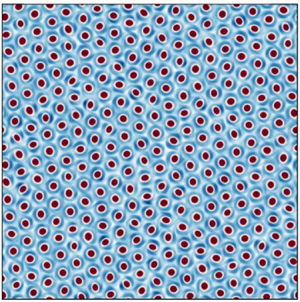Published online by Cambridge University Press: 08 April 2024

We study structure formation in two-dimensional turbulence driven by an external force, interpolating between linear instability forcing and random stirring, subject to nonlinear damping. Using extensive direct numerical simulations, we uncover a rich parameter space featuring four distinct branches of stationary solutions: large-scale vortices, hybrid states with embedded shielded vortices (SVs) of either sign, and two states composed of many similar SVs. Of the latter, the first is a dense vortex gas where all SVs have the same sign and diffuse across the domain. The second is a hexagonal vortex crystal forming from this gas when the linear instability is sufficiently weak. These solutions coexist stably over a wide parameter range. The late-time evolution of the system from small-amplitude initial conditions is nearly self-similar, involving three phases: initial inverse cascade, random nucleation of SVs from turbulence and, once a critical number of vortices is reached, a phase of explosive nucleation of SVs, leading to a statistically stationary state. The vortex gas is continued in the forcing parameter, revealing a sharp transition towards the crystal state as the forcing strength decreases. This transition is analysed in terms of the diffusivity of individual vortices using ideas from statistical physics. The crystal can also decay via an inverse cascade resulting from the breakdown of shielding or insufficient nonlinear damping acting on SVs. Our study highlights the importance of the forcing details in two-dimensional turbulence and reveals the presence of non-trivial SV states in this system, specifically the emergence and melting of a vortex crystal.